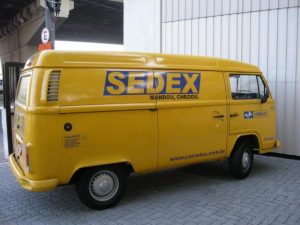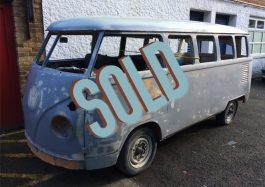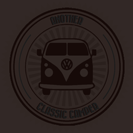Ajuda? +55 (11) 3280 6666 Brazil
History of the Volkswagen T2 ‘Splitscreen’
Introduction
The first generation of the Volkswagen Type 2 was available as a van for work or as a people carrier. It had the distinctive 2 front windscreens and the V shape on the front panel. Around the world it became affectionately known as the Bus, Barndoor, Kombi, Bullie, Microbus, Splitscreen, or Splitty, Samba, 21 Window and 23 Window, to name just a few of its nick names. Initially built until 1956 at Wolfsburg; from1956, it was built at the completely new Transporter factory in Hanover. Sharing many components with the VW Beetle, the first Transporters were powered by a 25Hp 1100cc Volkswagen air-cooled engine mounted in the rear. This was upgraded to the 1200cc 30 Hp engine 1953. Up until 1955 they were often called the Barndoor due to the enormous rear engine lid, they also had a flat roof at the front, while the later versions had the distinctive peak or overhang over the 2 front windscreens.
| Also Know As | Type 2, Microbus, Splittie, Samba, Kombi, Samba, Bulli |
|---|---|
| Manufactured | From 1950 to 1967 |
| Manufactured | From 1950 to 1967 |
| Fuel Types | Petrol |
| Engine Sizes | 1200cc, 1500cc |
| Conversion Types | Westfalia |
Model variants
During the 17 years of production there were a great many versions produced by VW, there was the basic panel van, an entry level Kombi or Bus is the 11-window. The Deluxe model featured eight rear side windows and two rear corner windows, making it the 15-window (not available in Europe). Meanwhile, Samba, officially called the sunroof Deluxe, came with eight small skylight windows giving it the name of the 23-window. From 1964 the wider tailgate meant the rear corner windows were discontinued, making the post 1964 models the 13-window and 21-window.
If you would like a more detailed year by year history of the iconic Splitty, please read below where you will find a list of key dates in the production of the Splitscreen model along with the chassis numbers for the relevant years.
Body styles
Volkswagen offered a huge range of models or variants of the VW Transporter, here are some of the factory combinations:

- Panel van, a delivery van without side windows or rear seats.
- Walk-Through models had single passenger and driver seat, allowing you to ‘walk through’ to the rear.
- Bulk head models had double passengers seat and single drivers seat (mostly on commercial versions like vans and pickups)
- High Roof Panel Van (German: Hochdach), a delivery van with factory fitted raised metal roof.
- Kombi, known in Germany as a Kombinationskraftwagen (combination motor vehicle), with side windows and removable rear seats, both a passenger and a cargo vehicle combined. Seats were easy to remove and the rubber floor mat made it very practical for work use.
- Bus, was a windowed van with more comfortable interior reminiscent of a car. Normally 3 rows of seats, headlining all the way through, heating vents front, middle and rear.
- Samba Deluxe, was the ‘up market’ version of the Bus, offering roof windows, sliding sun roof, 2 tone paint, dash board clock upgraded interior trim.
- Single Cab Pickup, seated 3 in the front. Rear flat bed load area with storage lockers underneath. Was also available with wider load bed and extended mirrors.
- Crew cab pick-up, normally a 6-seat version of the pickup. Known in Germany as a Doppelkabine. Again had under bed storage.
- Westfalia , also known as a , “Westy”. These came in a variety of finishes, with the option of an elevating roof. The interiors varied dependant on the year and if the vehicle was produced for European or USA / Canadian export. Most VW fans see the Westfalia camper as the ultimate conversion.
Commercial and camper conversions
 Because of the style of the VW Transporter and the fact that VW were very relaxed about 3rd party companies converting them to alternative uses, they became a variety of specialist vehicles such as, refrigerated vans, hearses, ambulances, police vans, fire engines and ladder trucks.
Because of the style of the VW Transporter and the fact that VW were very relaxed about 3rd party companies converting them to alternative uses, they became a variety of specialist vehicles such as, refrigerated vans, hearses, ambulances, police vans, fire engines and ladder trucks.
There was also a small ‘army’ of convertors around the world turning both vans and buses into campers. These varied drastically in quality and luxury. Some of the well-known UK converters were Danbury, Devon, Dormobile and Canterbury Pitt.
Production history, chassis numbers and techincal details
1950 Chassis Numbers – 20000001 > 20008112
February this year saw the first panel vans roll off the production line, followed in March by the Kombi and in May the first Buses or Microbuses. The engine size was 1131cc.
1951 Chassis Numbers – 20008113 > 20020112
June this year saw the Samba Bus roll off the production line and in December the first Ambulances were built.
1952 Chassis Numbers – 20020113 > 20041857
August this year saw the introduction of the very popular Pickup truck. This year also saw the introduction of synchronised 2nd, 3rd, and 4th gears.
1953 Chassis Numbers – 20041858 > 20070431
The only major change this year was the introduction of a larger (84Ah) 6 volt battery.
Jan 1954 to Feb 1955 Chassis Numbers – 20070432 > 20117902
January 1954 saw the introduction of the 30Hp 1192cc engine.
1955 Was the end of production of the Barn Door style models.
March 1955 to July 1955 Chassis Numbers – 20117903 > 20137605
The introduction of the ‘post Barn Door models’. The main changes were, the introduction of a full width dash board, spare wheel moved to behind the front seats, fuel tank is moved to over the gearbox and of course the introduction of the peak over the front windscreens. The other changes included the smaller 15″ wheels.
1956 Chassis Numbers – 20-137606 > 191466
This year saw the change in chassis numbers (no more ’20’ prefix), but the most important change was the moving of vehicle production from its birth place at Wolfsburg to a new factory in Hannover.
1957 Chassis Numbers – 191467 > 191466
1958 Chassis Numbers – 271676 > 371275
1959 Chassis Numbers – 371276 > 490622
1958 and ’59
Introduction of the Crew Cab or Double Cab pickup. The bumpers were changed to a more robust style and all gears became fully synchronised.
1960 Chassis Numbers – 490623 >632584
This year the 34 Hp engine was introduced and flashing indicators replaced the semaphore.
1961 Chassis Numbers – 632585 > 802985
1962 Chassis Numbers – 802986 > 971550
Petrol gauge becomes standard fitment, an optional 42 Hp engine was available and the front bench seat was made to hinge forward.
1963 Chassis Numbers – 971551 > 1144281
1500cc engine is introduced, the front indicators are made larger to the ‘fish eye style’. Panel vans are made available with a sliding door and the tailgate is enlarged as standard.
1964 Chassis Numbers – 1144282 > 1328871
You could now order patterned seat covers, the windscreen wipers were greatly improved along with the heating system.
1965 Chassis Numbers – 215000001 > 215176339
The 1500cc engine was improved to give 44 Hp. A two speed wiper motor was introduced along with a foot switch to dip the headlights. The pickup and crew cabs had a larger rear window introduced.
1966 Chassis Numbers – 216000001 > 216179668
At last 12 volt electrics were introduced.
1967 Chassis Numbers – 217000001 > 217148459
The end of the Splitscreen production.
* Between 1950 and 1967 when production of the Splitscreen model ended the production line had rolled out 1,477,330 vehicles. A version was made in Brazil by VW until the 1990’s.











